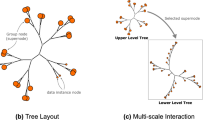Abstract
We present a new method to visualize data of the form y = f(x 1, x 2, x 3, x 4) that can be extended to n-dimensions. The essence of the method consists of slicing the data until the dimensions of the slices are reduced to n = 4 and then “unfold” the data into 3D space. Specifically, we map a visual representation of y onto the boundaries of a hypercube or other polytope and unfold those boundaries into 3D space. The display of the data provides a structural representation of 2D slices which can be adjusted and manipulated, allowing geometric properties like connectivity to be easily studied.
Graphical Abstract












Similar content being viewed by others
References
Aguilera Ramírez A., Pérez Aguila R (2002) Presenting methods for unraveling the first two regular 4D polytopes (4D simplex and the hypercube). In: Proceedings of the first international symposium on, Cyber Worlds, IEEE, pp 439–446
Asimov D (1985) The grand tour: a tool for viewing multidimensional data. SIAM J Sci Stat Comput 6(1):128–143
Bajaj CL, Pascucci V, Rabbiolo G, Schikore DR (1998) Hypervolume visualization: a challenge in simplicity. In: Proceedings of the 1998 IEEE symposium on volume visualization, pp 95–102
Banchoff T (1990) Beyond the third dimension: geometry, computer graphics and higher dimensions. Scientific American Library, New York
de Oliveira MCF, Levkowitz H (2003) From visual data exploration to visual data mining: a survey. IEEE Trans Visual Comput Graph 9(3):378–394
dos Santos SR, Brodlie KW (2002) Visualizing and investigating multidimensional functions. In: Proceedings of the symposium on data visualisation 2002 (VISSYM ’02). Eurographics Association, Aire-la-Ville, Switzerland, Switzerland, pp 173–182
Feiner S, Beshers C (1990) Worlds within worlds: metaphors for exploring n-dimensional virtual worlds. In: Symposium on user interface software and technology, Proceedings of the 3rd annual ACM SIGGRAPH symposium on User interface software and technology, Snowbird, Utah, United States, pp 76–83
Hanson A, Heng PA (1992a) Illuminating the fourth dimension. IEEE Comput Graph Appl 12:54–62
Hanson A, Heng PA (1992b) Four-dimensional views of 3D scalar fields. In: IEEE Visualization, Proceedings of the 3rd conference on Visualization ’92, pp 84–91
Inselberg A, Dimsdale B (1990) Parallel coordinates: a tool for visualizing multi-dimensional geometry. In: IEEE visualization proceedings of the 1st conference on visualization ’90, pp 361–370
Love AL, Pang A, Kao DL (2005) Visualizing spatial multivalue data. IEEE Comput Graphics Appl 25(3):69–79
Mihalisin T, Timlin J, Schwegler J (1991) Visualizing multivariate functions, data, and distributions. IEEE Comput Graph Appl 11(3):28–35
Miller J, Gavosto EA (2004) The immersive visualization probe for exploring n-dimensional spaces. IEEE Comput Graph Appl :2–11
Turney P (1984) Unfolding the tesseract. J Recreat Math 17(1):1–16
van Wijk J.J., van Liere R. (1993) HyperSlice—visualization of scalar function of many variables. In: Proceeding of the IEEE conference on visualization (Visualization 93), pp 119–125
Vos FM, van Gelder RE, Serlie IWO et al (2003) Three-dimensional display modes for CT colonography: Conventional 3D virtual colonoscopy versus unfolded cube projection.. Radiology 228(3):878–885
Acknowledgments
We thank Wonpil Im from the Center for Bioinformatics from the University of Kansas for providing us with his data (Sect. 5.2) and for meeting us to discuss visualization needs. The Hurricane Isabel data were produced by the Weather Research and Forecast (WRF) model, courtesy of NCAR and the US National Science Foundation. We also wish to thank the anonymous reviewers for their suggestions which led to a much improved paper.
Author information
Authors and Affiliations
Corresponding author
Rights and permissions
About this article
Cite this article
Gavosto, E.A., Miller, J.R. Visualization of data on unfolded hypercubes. J Vis 16, 85–94 (2013). https://doi.org/10.1007/s12650-012-0148-8
Received:
Revised:
Accepted:
Published:
Issue Date:
DOI: https://doi.org/10.1007/s12650-012-0148-8




